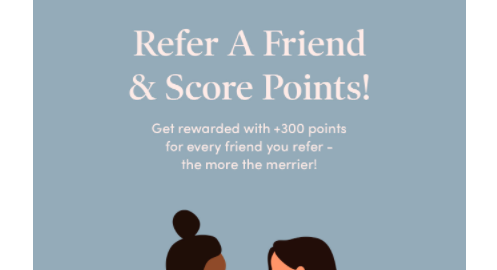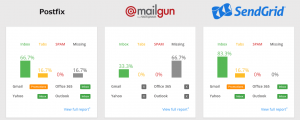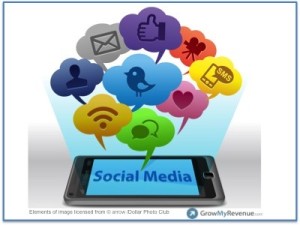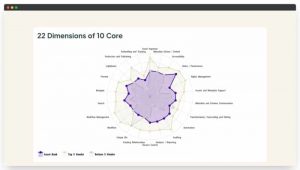Email communication is a tried and tested way to stay in touch with your customers. This is especially true for loyalty programs: keeping members in the loop regarding their progress, benefits, and reward prospects ensure both high engagement and high purchase frequency, as people won’t sit on their points. The question is: what kind of loyalty email types should you be sending?
This guide is dedicated to introducing the various messages you can send loyalty program members. It goes into great detail on the occasions when you could trigger a particular email, the email’s content, and how to ensure that the content is both appealing and relevant.
1. Invitation to Join – New Customer
Email type: Occasional
Trigger: For non-members, 1 week to 1 month after purchase
Making a great first impression is the first — and probably most important — step if you wish to win over customers. That’s why it’s essential to send new customers an enticing message.
This loyalty email should be geared towards customers who’ve made a purchase for the first time and have not yet registered to your system. Luckily, completing the purchase nowadays requires them to submit their email address; if you receive their consent during checkout, then you can contact customers in a GDPR-friendly manner.
Including an incentive in this email will act as a hook, to catch would-be members’ attention; it can be a coupon or gift exclusive to this email, or simply the welcome gift everyone receives after enrollment.
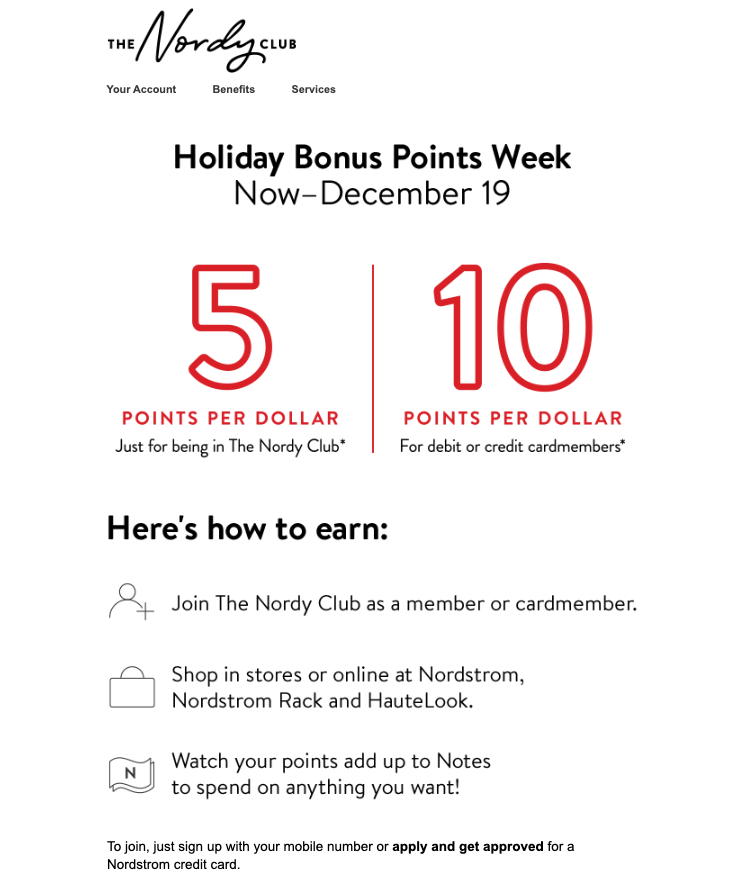
Instead of giving a direct offer, Nordstrom sent out invitations during a special promotional event.
2. Invitation to Join – Existing Customer
Email type: Occasional
Trigger: Quarterly messages for registered customers
Usually, when a customer creates an account at an online store, they’re automatically enrolled into the loyalty program as well. However, if the reward system is introduced later on in your brand’s lifecycle, you’ll need to remind registered members to join the loyalty program manually.
Similar to the loyalty email for first-time purchasers, it’s a good idea to include a special offer. You can go one step further though and share the details and long-term benefits of the loyalty program. This demographic has already shown interest in buying from you, so telling them about high-tier reward or experiential gift will resonate more strongly with them.
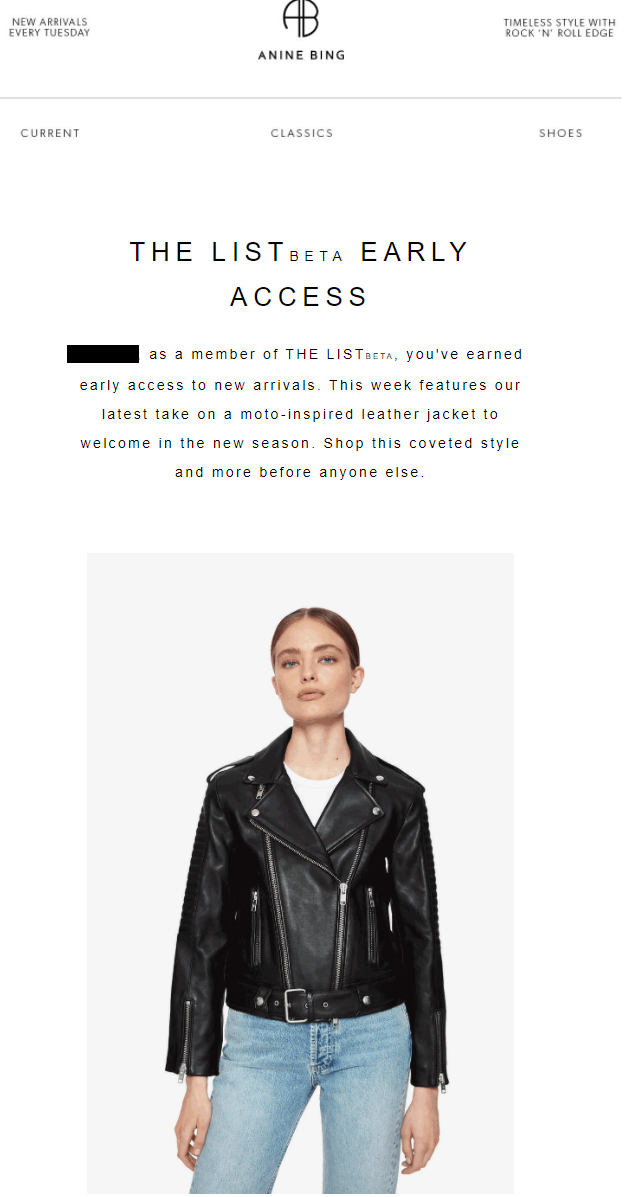
If you wish, you can invite your most dedicated customers to beta test your loyalty program before the official launch, just like Anine Bing did. Already loyal customers love the idea of being part of an exclusive group, way ahead of the public.
3. Welcome Email
Email type: Transactional
Trigger: Customer joins the loyalty program
The welcome email is another important milestone in your relationship with your customers. Other than sharing a heartfelt message, this email should walk fresh members through the basics. As part of the email, inform them about:
- Their point balance
- Their current tier (if you have a tiered system)
- The benefits associated with their tier
- Non-transactional actions they can earn points with (profile completion, newsletter subscription, etc.)
A well-designed welcome message gives customers a taste of what to expect from loyalty emails in the future. Also, the sooner you convince them to complete their profile, the better, as you can use the data they submit to start sending more personalized emails.
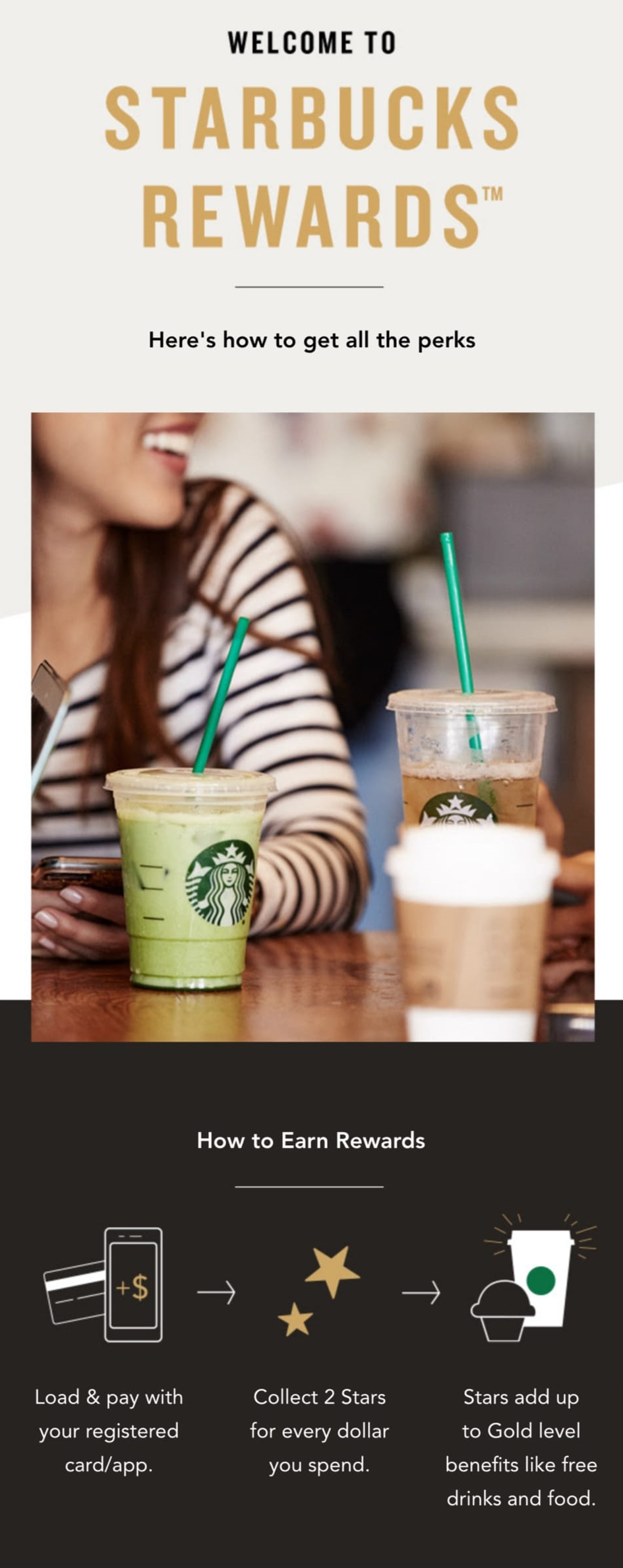
Starbucks nailed the feel and style of a good loyalty program welcome email. It’s to-the-point, uses recognizable imagery, and shows newcomers the ropes.
4. Loyalty Purchase
Email type: Transactional
Trigger: Loyalty member makes a purchase
Instead of sending customers a generic receipt recognizing their purchase, why not send a loyalty email showing them the progress they’ve made? Combine kind encouragement with an update on how many points customers have earned with their purchase, their current tier status, and how many points remain until they reach the next tier or reward.
High customer lifetime value is only achievable through communication that feels relevant. So make sure to flex those personalization muscles! For example, consider recommending products in the email, based on purchase history, as well as their likes and dislikes.
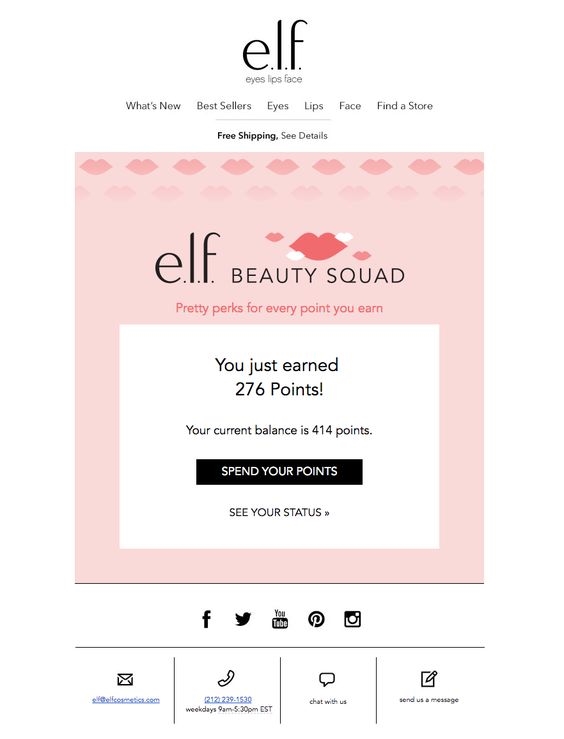
e.l.f. cosmetics decided not to overcomplicate its loyalty purchase email. It’s simple but still achieves its goal: informing the customer.
5. Points/Rewards Redemption
Email type: Transactional
Trigger: Loyalty member redeems their points or rewards
Once customers use their accumulated points to access a benefit, it’s a nice touch to reach out to them once more. In addition to confirming the successful redemption, this type of loyalty email serves to remind members about their remaining points, or other unused rewards.
The email should include:
- Information about the redeemed reward (reward name, points spent)
- Updated tier and points balance
- Current tier benefits
- Points until the next tier or reward
Remember: reward redemption is a happy moment for members. It is a time when their engagement level is at its highest. So add a few lines, congratulating them on their reward, so customers feel genuinely appreciated. Over time, this paves the way towards stronger brand love.
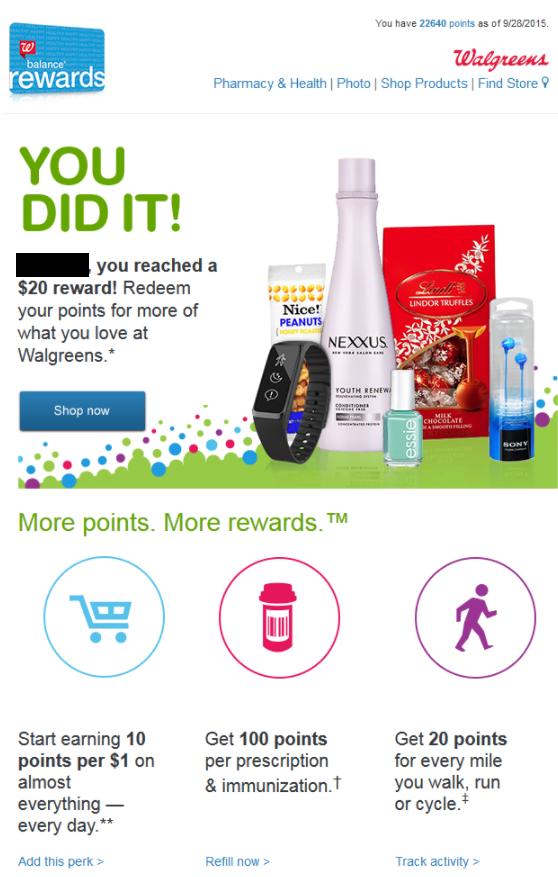
The email of Walgreens starts with some encouragement, then illustrates the reward possibilities with an image.
6. Double/Triple Point Events
Email type: Occasional
Trigger: Campaign based
Customers love the idea of bonus point campaigns because they get more value for their money. The primary way they learn about such deals is, of course, via email. Therefore make sure to send out a loyalty email detailing the rules, length, and benefits of the double- or triple-point campaign.
Around the holidays, such as Black Friday, Christmas, or Valentine’s Day, brands and retailers from all over the world initiate bonus point campaigns. One way to stand out from the crowd is to send relevant product offers in the email. Instead of pushing the same products to everyone, segment your offers based on what certain groups like, and increase the likelihood of impulse purchases.
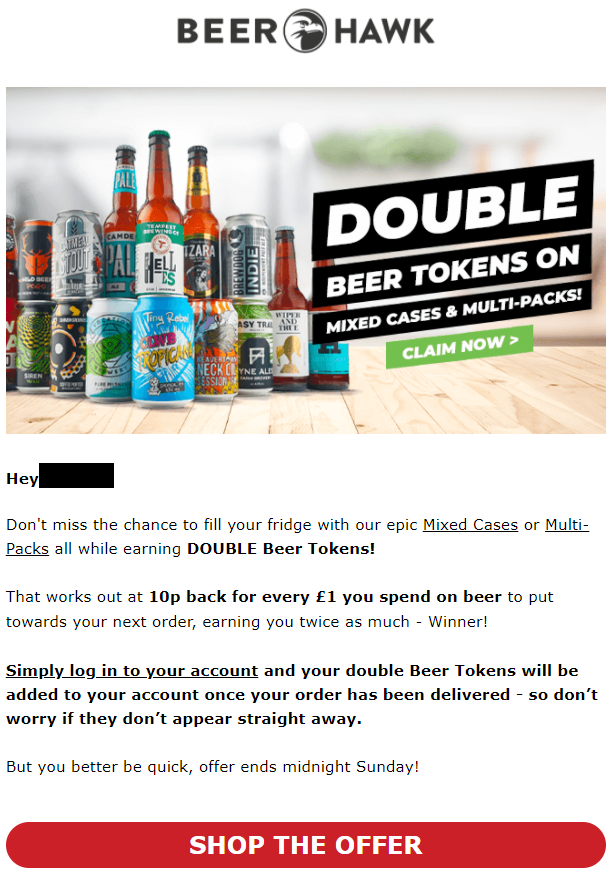
Beer Hawk checks all the boxes with its bonus point email: it’s informative, showcases the products that are involved in the campaign, and highlights the end date.
7. Birthday Reward
Email type: Transactional
Trigger: One week before the customer’s birthday
Birthday messages are probably the most effective tool in your marketing arsenal when you want to make people feel appreciated. If you know how to utilize surprise & delight mechanics, you can entice customers to buy their birthday present from you — even if they weren’t planning to do so.
The contents of the birthday email should be:
- A genuine birthday message that resonates with the recipient’s demographic
- A coupon or gift code they can redeem with their next purchase
- The usual membership data, such as current tier level and points
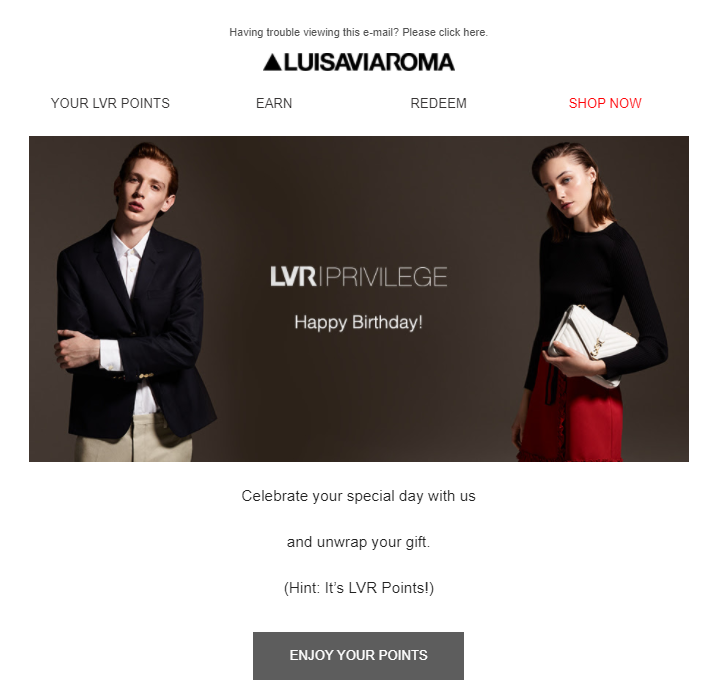
LuisaViaRoma’s birthday email campaign became the company’s highest converting emails, receiving 25% more opens and 40% more clicks than non-loyalty emails. That’s the power of surprise & delight!
8. Loyalty Tier Change
Email type: Transactional
Trigger: A change occurred in the member’s tier status
A change in a customer’s tier status could mean two things: they have either reached a new level as a loyal returning customer, or they have been downgraded as a result of inactivity. Both can warrant a loyalty email.
Ranking up is always a time for celebration in a loyalty program, and you should congratulate members for their dedication. However, customers often log out after completing checkout and don’t notice the change on their profile. That’s why it’s crucial to trigger an email telling them about all the rewards, perks, and benefits that they just unlocked.
Tier downgrades, on the other hand, happen when a member doesn’t make a purchase within a given timeframe. In this case, the email should make customers aware of all the privileges they’re now missing out on, in hopes of reactivating them.
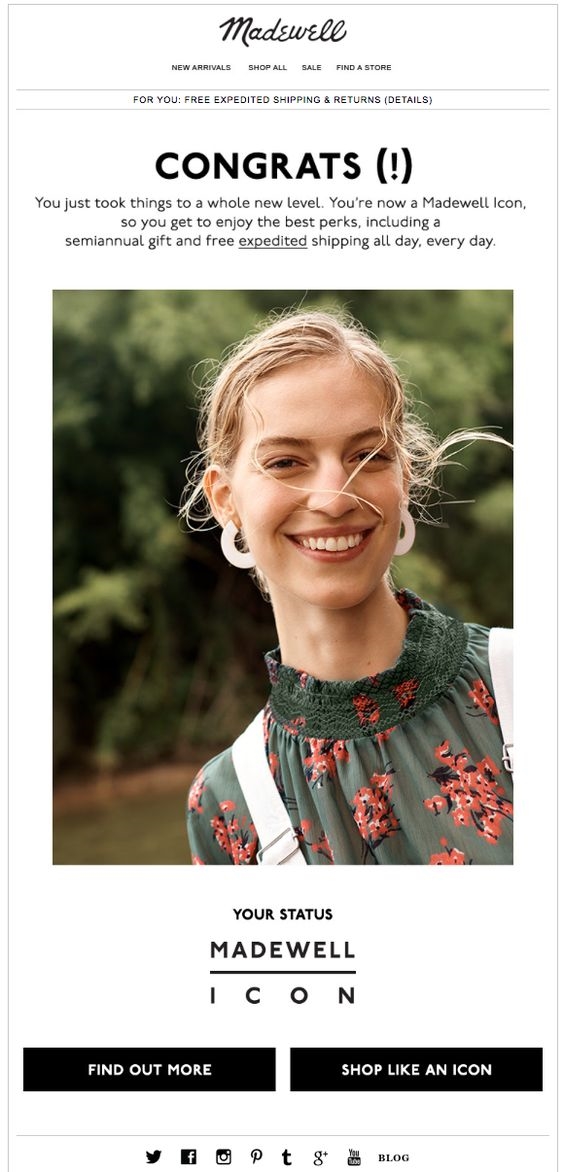
The message in Madewell’s email is short and sweet. The customer has earned enough points to qualify for free expedited shipping and can look forward to receiving two gifts a year.
9. Monthly Summary
Email type: Occasional
Trigger: End of the fiscal month
The monthly summary isn’t a mandatory loyalty email, but it still presents an opportunity to reach out to your members. As the name suggests, it’s a report that lists the various changes that have occurred in the past month. The email should include points gained & lost, new tier levels, any rewards that were redeemed and any other significant events.
You might be wondering what the point of repeating certain information is. At first, triggering an email to celebrate a new tier level, only to repeat it in the monthly summary seems redundant, but the aim here is to remain relevant. Without subtly reminding customers about their unused benefits, they might start sitting on their points and let them expire — more on that later.
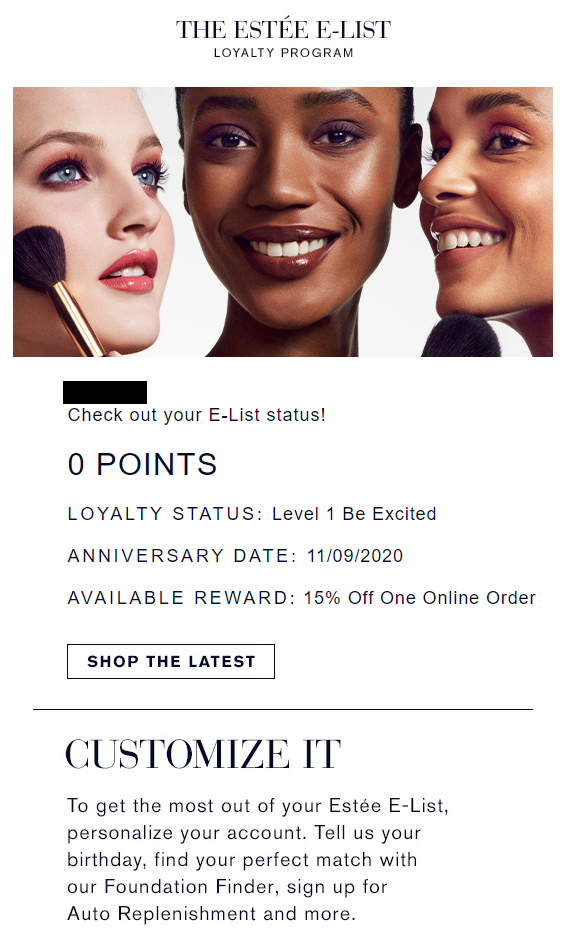
Estée Lauder spices up its loyalty email with a brief promotion of its other features.
10. Loyalty Program Update
Email type: Occasional
Trigger: A change or new feature has been introduced
A healthy loyalty program should continually evolve. Every time you add or remove a feature or change the rules, you should send out an email to all members. Changing the cost of certain rewards without telling customers in advance will undoubtedly result in a bad experience. The same could be said about adding a new feature; if you don’t hype it up, fewer customers will interact with it.
There are a couple of reasons that could warrant an official notification:
- Introduction of a new feature, such as gamification
- Retirement of an old feature
- New additions to your reward catalog or added benefits, like free shipping
- Changing reward costs
- Updates to your data policy
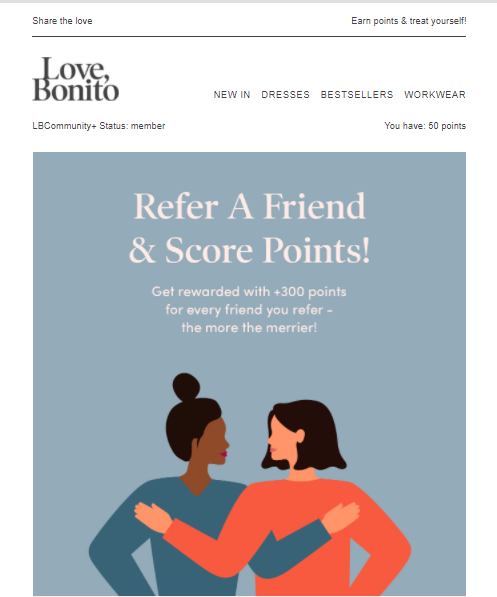
Word of mouth and virality were important KPIs for Love, Bonito, which is why the company promoted its friend referral feature via email.
11. Points Expiration
Email type: Transactional
Trigger: 30 days before the points expiration date
Speaking of bad customer experiences, there’s nothing people hate more than seeing their hard-earned points get wiped out. Since the only way to keep points from expiring is to make another purchase, it’s also in your best interest to notify members in advance.
Highlighting expiration rules in the FAQ section of your loyalty program is essential, but more importantly, send an email about it. Emails are the best and most direct way to catch the customer’s attention. The message should clearly state how many points the person will lose by not taking action. To maximize the effect of this email, add a special offer encouraging customers to redeem their remaining points or make a purchase.
12. Loyalty Tier Expiration
Email type: Transactional
Trigger: 30 days before the tier expiration date
Tier expiration is in many ways similar to point expiration, with a few crucial differences. For starters, tiers expire less often. The chances are high that people will forget about this eventuality, so a reminder email has a greater impact.
The other big difference is that a tier downgraded means members will lose significant benefits. The tier expiration email should highlight what customers will miss out on, convincing them to make a purchase and maintain these fantastic benefits.
Supercharge Your Email Communication
Armed with this knowledge, building email campaigns for your loyalty program will be much easier. Pure-play loyalty providers and marketing automation providers go together like peanut butter and jelly, as the two technologies complement each other without overlap, allowing you to personalize emails with loyalty data.
If you wish to learn more about the capabilities of a next-gen loyalty program, we are ready to support you with the best technology available.
Digital & Social Articles on Business 2 Community
(92)
